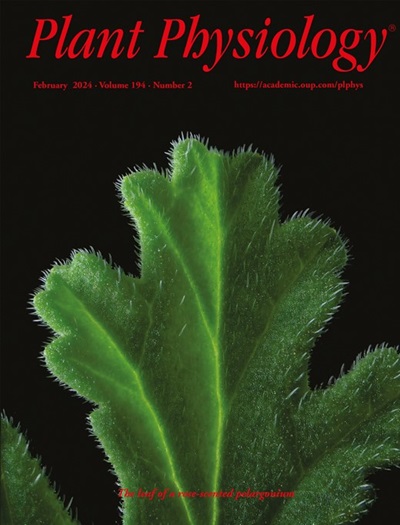STAY-GREEN overexpression in dark-incubated leaves promotes the formation of transitional chromoplast-like plastids
IF 6.5
1区 生物学
Q1 PLANT SCIENCES
引用次数: 0
Abstract
The transition of chloroplasts into chromoplasts and gerontoplasts during fruit ripening and leaf senescence, respectively, involves chlorophyll breakdown and chloroplast deterioration. Chlorophyll removal is carried out by several enzymes. Among them, the Mg-dechelatase STAY-GREEN (SGR) catalyzes the first step of chlorophyll degradation. The tomato green-flesh (gf) and pepper chlorophyll retainer (cl) mutants are SGR loss-of-function mutants that maintain high levels of thylakoid structures during chromoplast development in ripening fruits. Here, by overexpressing SGR in non-illuminated Nicotiana benthamiana leaves, we demonstrated that SGR triggers the onset of chloroplast deterioration, resulting in the formation of orange leaf sectors containing plastids with carotenoid-bearing structures, although carotenoid production is not induced. Metabolite, microscopy, and transcriptome analyses suggested the onset of chloroplast senescence, indicating a possible transitional plastid stage in SGR-overexpressing regions. Overall, our work demonstrates the remarkable ability of plant plastids to adapt their ultrastructure to accommodate the precise metabolic composition of various developmental and environmental contexts.STAY-GREEN的过度表达在深色培养的叶片中促进过渡性色质体样质体的形成
果实成熟和叶片衰老过程中叶绿体向色质体和老年质体的转变分别涉及叶绿素分解和叶绿体退化。叶绿素的去除是由几种酶完成的。其中Mg-dechelatase STAY-GREEN (SGR)催化了叶绿素降解的第一步。番茄绿肉(gf)和辣椒叶绿素保留体(cl)突变体是SGR功能丧失突变体,在成熟果实的色质体发育过程中保持高水平的类囊体结构。在这里,通过在未光照的烟叶中过表达SGR,我们证明SGR触发叶绿体退化,导致橙色叶区形成含有类胡萝卜素结构的质体,尽管类胡萝卜素的产生不会被诱导。代谢物、显微镜和转录组分析表明,叶绿体开始衰老,表明sgr过表达区域可能进入过渡质体阶段。总的来说,我们的工作证明了植物质体具有非凡的能力来调整其超微结构,以适应各种发育和环境背景的精确代谢组成。
本文章由计算机程序翻译,如有差异,请以英文原文为准。
求助全文
约1分钟内获得全文
求助全文
来源期刊

Plant Physiology
生物-植物科学
CiteScore
12.20
自引率
5.40%
发文量
535
审稿时长
2.3 months
期刊介绍:
Plant Physiology® is a distinguished and highly respected journal with a rich history dating back to its establishment in 1926. It stands as a leading international publication in the field of plant biology, covering a comprehensive range of topics from the molecular and structural aspects of plant life to systems biology and ecophysiology. Recognized as the most highly cited journal in plant sciences, Plant Physiology® is a testament to its commitment to excellence and the dissemination of groundbreaking research.
As the official publication of the American Society of Plant Biologists, Plant Physiology® upholds rigorous peer-review standards, ensuring that the scientific community receives the highest quality research. The journal releases 12 issues annually, providing a steady stream of new findings and insights to its readership.
 求助内容:
求助内容: 应助结果提醒方式:
应助结果提醒方式:


